As part of the 2015 Building Better Healthcare Awards, 10 gongs were handed out in the Building Design category, which recognises and celebrates excellence in health and social care architecture.
The winners were chosen from more than 100 entries across nine categories, with the judges choosing two winners in the Best Primary Care Development category due to the strength of the nominations.
Prizes were presented by celebrity host, Gethin Jones, and included two special awards, the Grand Prix Award, chosen by the judges from entries across all nine categories; and the Innovation in ProCure21+ Award, open to all the principal supply chain partners involved in the ProCure21+ framework..
Here, we profile the winners of each of the awards.
Award for Innovation in Procure21+
Highly commended:
Kier Group and Gilling Dod Architects for integrating health services at the Royal Stoke University Hospital
In 2014, Kier was awarded the contract for the £175m ‘Integrating Health Services in Staffordshire’ programme of work for University Hospital of North Midlands NHS Trust (UHNM).
The project was developed in response to the Francis Report into Stafford Hospital, since renamed County Hospital, and aimed to identify key improvement areas and provide tangible benefits for staff and patients.
In the first 12 months Kier, UHNM and the wider team, including architect, Gilling Dod, developed a solution to reconfigure the facilities and infrastructure to support the revised clinical model for County Hospital, Stafford.
To achieve this, they worked together to design, build and operate three priority projects at Royal Stoke University Hospital – the Springfield Centre, Lyme Wards and a Critical Care Unit.
Completing these early works enables the trust to transfer the necessary services from County Hospital to implement the required changes as outlined in the Francis Report.
As the team progressed through the design and construction, they were able to identify cost savings of £31,000 in P21+ Stage 3, and a total of £232,000 savings overall. They were also able to save four weeks on the building programme from phase one to two.
The BBH Awards judges added: “The speed with which they completed this development, in just 16 weeks, shows just what can be done. In the NHS this was a remarkable achievement.”
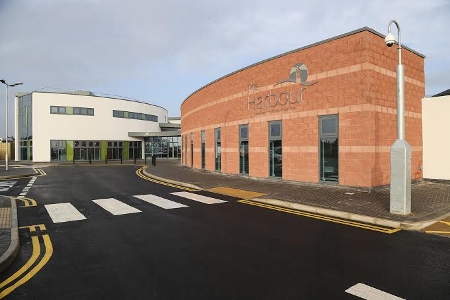
The Harbour won the Award for Innovation in Procure21 Plus
WINNER:
Integrated Health Projects for The Harbour, Blackpool (Integrated Health Projects (IHP) - VINCI Construction UK and Sir Robert McAlpine; Lancashire Care NHS Foundation Trust and Gilling Dod Architects)
The Harbour is a new 154-bed mental health inpatient hospital situated just outside Blackpool. The £41m scheme for Lancashire Care NHS Foundation Trust (LCFT) represents a truly-unique and innovative funding mechanism combining public and private partners via the first limited liability parntnership (LLP) joint venture in the country - Redrose Corporate Services and Lancashire Care NHS Foundation Trust.
Developed by the Integrated Health Projects consortium, and designed by Gilling Dod Architects, the new facility brings five services together under one roof, providing specialist dementia, advanced care, functional acute and psychiatric intensive care unit wards, as well as a Section 136 suite, therapy hub and community team base. These services are situated along the main ‘street’, a concept that links living and sleeping areas and activity and therapy zones with the main reception and shared spaces to create a real community feel.
Working in partnership with LCFT, the design team partners undertook a full review to ensure the facility maximised operational efficiency. Through this process they were able to increase the capacity by an additional 11 beds by optimising the circulation space while at the same time reducing the overall internal floor area by 10% and optimising the number of nurses per bed required. Not only did this provide additional service user capacity, it has also reduced the operating costs of the facility through the reduction of unnecessary floor space - and at no additional cost. Constructed using innovative off-site techniques such as GRP en-suite bathroom pods, and with a standardisation of specifications and FM solutions, project affordability achieved a 10% saving on initial GMP.
Adrian Drinkwater, business development manager at VINCI Construction, said: “In order to achieve cost reduction requirements we not only optimised the design, we also innovated throughout the construction process, notably during the major earth work phase in which we moved the orientation and position of the building footprint on the site, resulting in a saving in excess of £500,000 and a four-week programme reduction. We also changed the construction method from a steel frame solution to load-bearing masonry, which also yielded a large cost saving.
“Through the use of off-site manufacturing, innovative construction and optimisation of design, we reduced the overall cost of the scheme by £5m.”
In addition, environmental sustainability was considered, with a specially-constructed ecology basin and new wetland fostering local wildlife. The Harbour also utilises a sustainable energy source, with 72% reduction in carbon emissions via a new bio-mass energy plant.
Choosing it as their winner, the judging panel said: “This is an example of public/private funding at its very best.
“It’s forward-thinking in terms of the way it was financed and it very clearly demonstrates efficiency in the way in which it was built.”
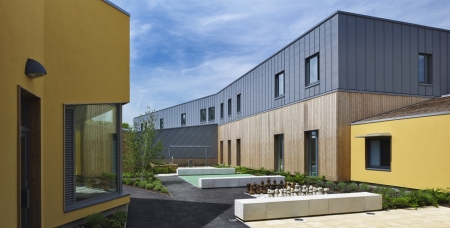
Kingfisher Court won the coveted Grand Prix Design Award
Grand Prix Design Award:
WINNER:
P+HS Architects for Kingfisher Court
Kingfisher Court is an exemplar mental health facility providing a beautiful, robust, secure and safe environment for patients.
Nestled into the surrounding woodland, and with landscaped courtyards, hotel-like leisure and therapy spaces, and significant integrated artworks, it sets a new standard for healing environments and supports service users recovering from mental illness.
The design for the £42m scheme emerged following unprecedented stakeholder consultation including visits, workshops , 2,000 hours of meetings and discussions and even a sleepover for representative consultees, including service users, commissioners and trust executives. The design team also walked the ridgeways in the surrounding countryside to develop the massing strategy: two sinuous building blocks following the contours of the site, with the scale only revealed by an aerial view.
A welcoming entrance foyer with café and shop opens onto a network of 'streets' leading to therapy rooms, sports and horticultural areas, via a series of meeting and pausing places.
After much debate, the airlock security lobby was omitted from the design, one of many measures taken to make the building feel non-institutional.
The ward environment is also special, with light, airy day rooms, intimate quiet rooms and bedrooms with sloping ceilings, window seats and views.
The unique ward plan has access to two courtyards: one for active pursuits and the other for more-contemplative occupations. There are other gardens, too, including a café courtyard, horticulture and therapy garden, and sports and recreation areas.
Sustainable design principles literally shaped the building, which is optimally orientated for natural light, cross ventilation and solar shading. Heat pumps, building management system, and low-energy lights further reduce energy use.
“This is a quiet building, intimate in scale, and never revealing its size except by aerial view,” said a spokesman for P+HS Architects.
“It’s a building that blends with its surroundings and one that you can settle into and engage with at a level appropriate to your particular condition and needs, whether you are a service user, staff member or visitor.”
He added: “Kingfisher Court is the result of dedication, collaboration and vision. It provides the very-best environment for recovery-centred care and purposeful activity, enabling people to live their lives in a meaningful way.”
The BBH Awards judges said of the entry: “There are stunning views and lovely external spaces, as well as some cleverly-designed internal rooms. Without trying to be homely, it’s a very-comfortable building. It’s the most-interesting building we have looked at.”
Best Acute Hospital Development
Highly commended:
Guildhouse for the New Queen Elizabeth II Hospital, Welwyn Garden City
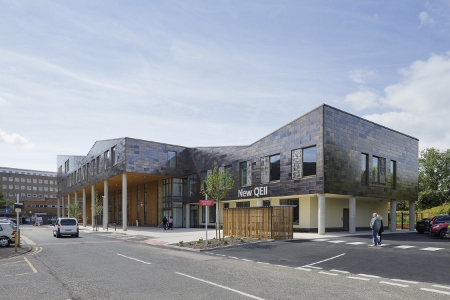
The New Queen Elizabeth II Hospital, Welwyn Garden City
The New QEII Hospital presents a striking centrepiece for the changing face of healthcare. The hospital fully integrates primary, community and acute outpatient services within a single fully-accessible and sustainable building and is at the forefront of transforming hospital services in Hertfordshire.
Welcoming visitors along its wide, covered colonnade; large glazed areas are punctuated by natural materials, hand-fired tiles, and window screens that are both functional and good looking.
The main entrance leads to a large accessible courtyard, with quiet contemplative spaces, outside seating areas, and a planting scheme developed with input from local service users.
Waiting areas and services wrap around the courtyard while full-height glazing provides natural light and garden views deep into the building. And a variety of floor coverings and structural materials, combined with more intimate spaces, ensure a non-threatening environment for more-vulnerable patients.
The New QEII exceeds the requirements of the Equalities Act and Secured by Design approach. It also meets national and local infection control measures and a sophisticated access system allows flexible use of different areas 24/7.
“It’s an exciting start for the New QEII,” said urgent care nurse practitioner, Tracy Byrne.
“The building has a great open feel with natural light, which is fantastic and will really help patient care.”
The judges added: “This is a good-looking building. It looks vast until you realise quite how much is happening inside it, and then you see how clever the design is.
“There is a deliberate oddness to the scale of it and that really works. When the trees mature it will be even more fabulous.”
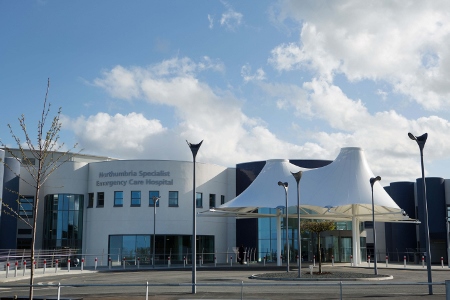
Northumbria Specialist Emergency Care Hospital
Gardiner & Theobald for Northumbria Specialist Emergency Care Centre
Northumbria Specialist Emergency Care Hospital is the UK’s first purpose-built dedicated emergency care hospital and treats patients from Northumberland and North Tyneside who are seriously ill or injured.
The result of 10 years’ work by clinicians; it has emergency care consultants on site 24/7, with consultants specialising in a range of conditions available every day to speed up specialist care, maximising chances of survival and a good recovery.
It was designed by clinicians focusing on patient pathways to ensure the best care.
Nursing staff insisted on central nursing stations giving clear sight lines of patients, and departments are arranged to facilitate patient flow. This includes diagnostics located in the emergency department for the first time, ensuring immediate access and results.
Large rooflights and windows bring natural light into the building and into each single en-suite patient room, which ensure the utmost privacy and dignity. This is illustrated in critical care, where the large circular space is flooded with daylight, giving recovering patients stunning views of the countryside.
Art, including a mobile hanging in the main entrance, is used as a therapeutic medium to further improve the environment.
The judges said: “This has been designed with the clinical pathway and clinicians in mind.
“When you compare it to standard A&E departments, it’s pretty wonderful. The A&E bays really let the natural light in and there is good visibility.”
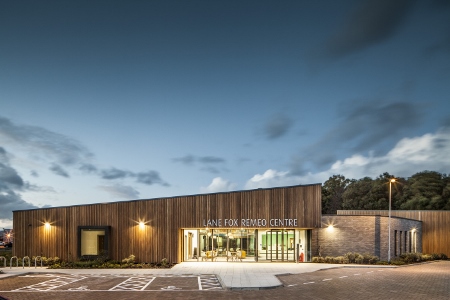
Murphy Philipps Architecture won Best Acute Hospital Development for the Lane Fox REMEO Centre
WINNER:
Murphy Philipps Architecture for Lane Fox REMEO Centre (Murphy Philipps Architecture, DD Porter, BOC Healthcare, Guys and St Thomas NHS Foundation Trust)
Built on the edge of an acute hospital site, but orientated to maximise views of neighbouring ancient woodland, the new Lane Fox REMEO Unit provides a therapeutic retreat with a homely atmosphere, supported by cutting-edge technology and world-leading clinical expertise.
The unit is a high-tech 20-bed satellite centre to the world-renowned Lane Fox Unit at St Thomas’ Hospital in London – a national centre for the management of chronic respiratory failure.
It is the UK’s first purpose-built centre to wean respiratory patients off invasive mechanical ventilation, thereby improving recovery rates and enabling patients to return home.
The building – the name of which translates as ‘I return home’ in Latin - was developed as part of a landmark public-private partnership between Guys and St Thomas NHS Foundation Trust and BOC.
Praised by the planners as ‘a worthwhile contribution to its setting’, the building has been sensitively located adjacent to ancient woodland, and a nearby public footpath has been reinstated and enhanced.
The unit has been built to an innovative four-bed bay layout, which was developed so that every bed bay has its own window with a view towards the woodland.
All public and social spaces have high-level glazing; and circulation routes terminate at views of the landscape so that natural daylight permeates all areas of the building. Extensive glazing with large folding doors, shaded terraces and a central courtyard, blur the boundary between indoor and outdoor spaces, promoting a calm and therapeutic atmosphere.
All indoor and outdoor areas are discretely provided with medical gases to maximise accessibility for all patients and in the patient bedrooms, a bespoke joinery bedhead with integrated storage and gases promotes a domestic, non-institutional setting without compromising clinical functionality.
The rooms have also been laid out to optimise efficient staff work patterns and maximise staff visibility of the most-vulnerable through the use of glazed screens and outboard en-suite bathrooms.
Patients and their families and carers worked with the design team from the very outset and an artist was commissioned to provide a series of four bespoke murals in the key social spaces, forming a continuous narrative of recovery and respiration.
Optimisation of passive design maximises natural daylight and minimises solar gain, alongside a highly-efficient building fabric, low air permeability levels, and use of sustainable building materials and water conservation.
To maximise the potential for future flexibility, infrastructure has been put in place to allow future division of the four-bed bays into single bedrooms with en-suite bathrooms.
BBH Awards judge, Andy Law, said: “This is a very confident building. It connects the inside and outside really well and there is a very human feeling about the spaces, which are also clinically functional.
“I can imagine myself getting better in a place like that.”

The New Queen Elizabeth II Hospital was highly commended in the Best Primary Care Development Category
Best Primary Care Development
Highly commended:
Guildhouse for the New Queen Elizabeth II Hospital, Welwyn Garden City
The New QEII Hospital fully integrates primary, community and acute outpatient services to set a new standard for the delivery of 21st-century health and social care services.
An urgent vare ventre provides 24/7 support for those with minor illnesses or injuries, alongside an out-of-hours GP facility.
Rapid assessment and a full range of outpatient services, supported by comprehensive diagnostics, enable patients to be treated without having to travel to the acute hospital.
It also has a dedicated children’s outpatient area offering fully integrated assessment, diagnosis and treatment in an exclusively child-friendly area.
In addition, the building provides a venue for a wide range of local health and care services that people use most often.
The building makes the most of natural light and ventilation and achieved a BREEAM ‘Excellent’ sustainability rating.
A spokesman for Guildhouse said: “The facility provides out-of-hospital care, preventing unnecessary admissions and ensuring the majority of patients can be seen locally. It far exceeds the performance and compliance of the buildings it replaces.”
The judges added: “It’s a very good building with a good range of services in it, which shows what can be done to enhance primary care services.”
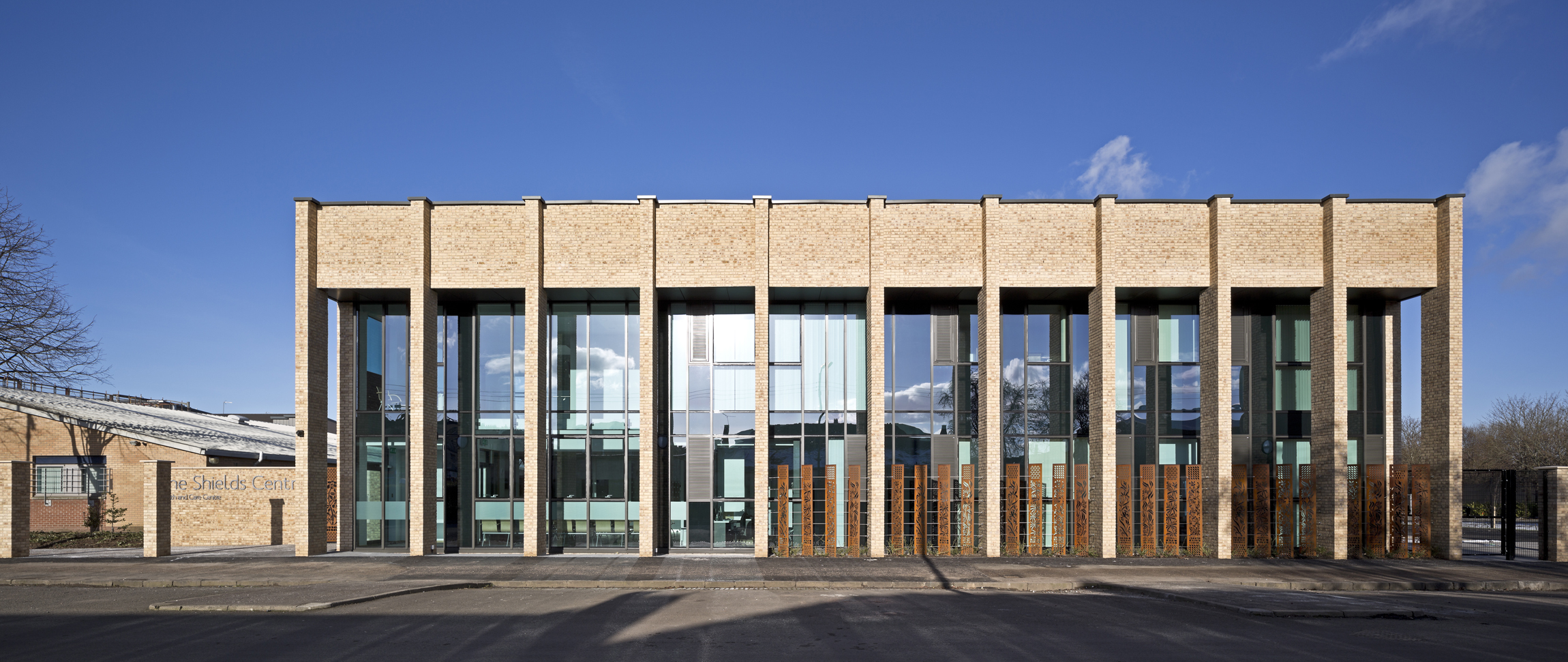
The Shields Centre
WINNERS:
Hub West Scotland for The Shields Centre (Hub West Scotland, NHS Greater Glasgow and Clyde, Anderson Bell + Christie, CBC)
Hub West Scotland, in partnership with NHS Greater Glasgow and Clyde, has developed The Shields Centre, a £2.7m health and care facility in Glasgow.
Fully funded by the health board, this purpose-built facility was designed with significant involvement of service users to meet both current and future health and social care needs for a unique population on the south side of Glasgow.
Built on the site of a former dilapidated and under-used blaze football pitch, the development has made a significant contribution to improving accessibility in the area through the co-location of a community centre and the new Glendale Primary School and Gaelic school; and by bringing community health and social care services under one roof for the first time.
Futureproofing was a key aim of the design, ensuring long-term flexibility and value for money. This was achieved through various meetings with the end users to standardise rooms that could be multi-functional and bookable.
A weekly diary of use was utilised to ensure the correct numbers of rooms was identified and ensuring that the building maximised every square metre of the floorspace at all times. These standardised rooms are now being rolled out across all centres currently being developed by the health board.
This new health centre accommodates two existing local GP practices, as well as social workers, health visitors, the district nursing team, CHP facilities and the Pollokshields Health Shop, which offers health improvement services.
The building scale takes its cue from the nearby tenements, and likewise the brick selection is contemporary and reflective of the sandstone warmth of the residential tenements, contributing to the local fabric regeneration.
The building is centred round a bright, airy, double-height waiting and reception area with short wings containing consulting rooms leading off the main public space.
A new walled garden and teaching allotment links the building with a community centre and showcases food growing techniques for heathy living, making an important link between food and health.
Artist, Alex Hamilton, worked with numerous local community groups to generate patterns. These were then incorporated into fins and manifestations, which offer the privacy required by the building users while helping to maintain natural daylight.
The judges described the building as ‘outstanding’.
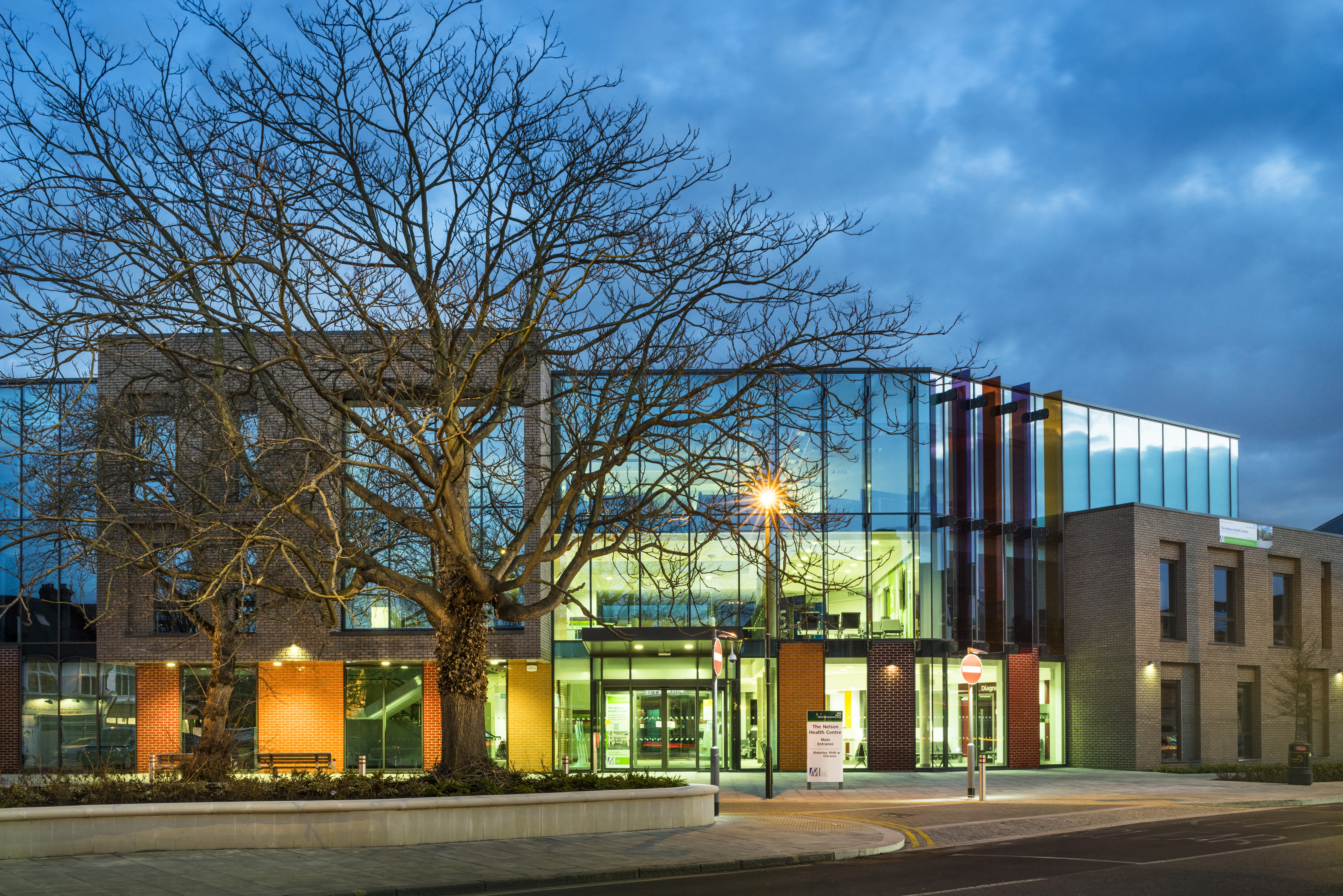
Murphy Philipps Architecture won Best Primary Care Development for the Nelson Health Centre
Murphy Philipps Architecture for Nelson Health Centre (Murphy Philipps Architecture, Rydon)
The new Nelson Health Centre makes a significant contribution to the regeneration of the local area, repairing the urban grain and enhancing the civic space along the street frontage.
The building, delivered through NHS LIFT, accommodates state-of-the-art clinical accommodation within a flexible and therapeutic environment, enriching the patient experience and optimising staff efficiency.
The original, locally-listed, facades of the Nelson Hospital pavilions have been retained, incorporated in the new elevation, and given greater prominence and clarity along the Kingston Road frontage. The articulation, rhythm and scale of the original pavilions informed the new elevations, and external materials include coloured glazed ceramic bricks which are in keeping with the glazed tiling prevalent on local residences.
Internally, the combination of old and new is celebrated by exposing and contrasting the original and recent brickwork. The scheme includes extensive landscaping, especially in front of the building where the narrow pavement and parking areas have been remodelled to create a broad tree-lined avenue that culminates in a landscaped public space in front of the main entrance.
Behind the facade, lies 5,600sq m of new healthcare accommodation laid out to ease the journey for patients while optimising staff efficiencies.
Nelson Health Centre is a fundamental catalyst within the Better Healthcare Closer to Home network, which aims to radically reshape and modernise health services in Sutton and Merton by providing more care locally.
The building has been designed to support integrated services such as the one-stop-shop for older people, which includes a dedicated drop-off area and entrance. The design of the internal spaces has been developed in accordance with the principles of evidence-based design and the integration of colour, artwork and historical memorabilia within the interior contributes to the intuitive sense of place and enhances wayfinding.
There is also a continuous relationship between the inside and outside, most evident along the patient routes, with positive distractions provided by pause points adjacent to lightwells and views outside of familiar local landmarks.
A number of strategies have been implemented to allow for future flexibility and adaptability, including the use of generic modular rooms that can suit a wide range of future activities. The internal layouts are designed to allow different groupings of rooms so that a range of different clinic sizes can be accommodated without requiring any physical changes to the building.
The judges said of the building: “This development shows very clever use of the old buildings in the area. It fits in remarkably well with its surroundings.
“Some parts of the window detail really are very clever and it shows proper use of an atrium.”
Best Mental Health Development
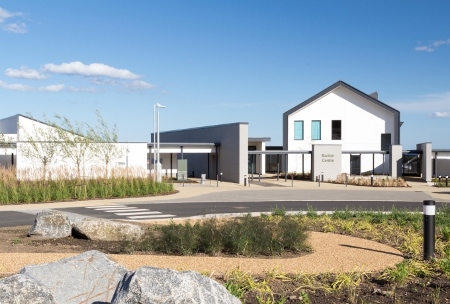
Hopewood Park (Medical Architecture)
Highly commended:
Medical Architecture for Hopewood Park
In 2009 Northumberland, Tyne and Wear NHS Foundation Trust sought the views of local people, service users, carers, and staff on providing improved mental health services in the Sunderland area.
This modernisation culminated in the development of Hopewood Park, a new integrated campus which marks a step-change in the quality of design for psychiatric care.
The scheme provides 122 inpatient beds for adults and older people along with shared therapy and support facilities.
The extraordinary site overlooking the North Sea inspired the name of the area, Ryhope, which describes a valley cutting sharply through the landscape. These natural features underpin the creative evolution of the architecture, landscape, art and wayfinding strategy, reflecting the movement of patients, visitors and staff through the site.
Benefitting from years of design refinement on various projects with the trust, the inpatient wards are standardised to flexibly accommodate the widest range of service configurations.
Accessed via a landscaped front garden, they offer an abundance of natural daylight and are paired to allow safe and efficient staffing while designed to foster recovery through the placement of safe, generous and relaxing places for patients and staff.
One service user said: “The building looked very bright and modern from the outside and I already knew the inside would look lovely, but I was pleasantly surprised at exactly how lovely it is. It doesn’t feel like you’re walking into a psychiatric hospital.”
The BBH Awards judges added: “We love the scale of this and the deep section windows. It’s lovely that you can look through the building and see the sea beyond. There are nice window details and it is overall a very neat building.”

P+HS Architects also won the award for Best Mental Health Development for Kingfisher Court
WINNER:
P+HS Architects for Kingfisher Court
Kingfisher Court is an exemplar mental health facility providing a beautiful, robust, secure and safe environment for patients.
Described by the judges as the ‘most-interesting building of the 2015 competition’, it is nestled into the surrounding woodland, with landscaped courtyards, hotel-like leisure and therapy spaces, and significant integrated artworks, setting a new standard for healing environments and supporting service users to recover from mental illness.
The £42m scheme comprises an 86-bed adult mental health unit, five wards, a foyer, café, shop, guest bedrooms, activity and therapy rooms, ECT facility, Section 136 suite, tribunal suites, and supporting accommodation.
The design emerged following unprecedented stakeholder consultation including visits, workshops, more than 2,000 hours of meetings and discussions, and a sleepover for representative consultees, including service users, commissioners and trust executives.
The design team walked the ridgeways in the surrounding countryside to develop the massing strategy - two sinuous building blocks following the contours of the site. The building scale is only revealed in the aerial view, a deliberate design move.
From ground-level vantage points the building, though large, always appears intimate and human in scale. The welcoming entrance foyer with a café and shop opens onto a network of 'streets' leading to therapy rooms, sports, and horticultural areas via a series of meeting and pausing places, deliberately creating informal opportunities for social interaction.
After much debate, the airlock security lobby was omitted from the design, one of many measures taken to make it less institutional in feel.
The ward environment is light, with airy day rooms, intimate quiet rooms and bedrooms with sloping ceilings, window seats and views.
Contact with external space is key. The unique ward plan has access to two courtyards: one for active pursuits and another for more contemplation. There are also other gardens include the café courtyard, horticulture and therapy gardens, and sports and recreation areas.
Sustainable design principles literally shaped the building, which is optimally orientated for natural light, cross ventilation, and solar shading. Heat pumps, BMS, and low-energy lights reduce energy use and materials were chosen to reduce waste, including structurally-insulated wall panels and bathroom pods.
One of the most-absorbing challenges was how to make a building which needs to be anti-ligature, and exceptionally robust, look and feel non-institutional and homely. As a result great care was taken to specify appropriate components and materials and risks were reviewed with consultees.
Diana Cole of P+HS Architects said: “Kingfisher Court is the result of dedication, collaboration and vision. It provides the very-best environment for recovery-centred care and purposeful activity, enabling people to live their lives in a meaningful way.”
The BBH Awards judges said: “This has been built on a sloping site and is a big, big single-storey building, but it has been very cleverly designed and there are stunning views and lovely external spaces, as well as some clever internal rooms.
“Without trying to be too homely, it’s a very comfortable building.”
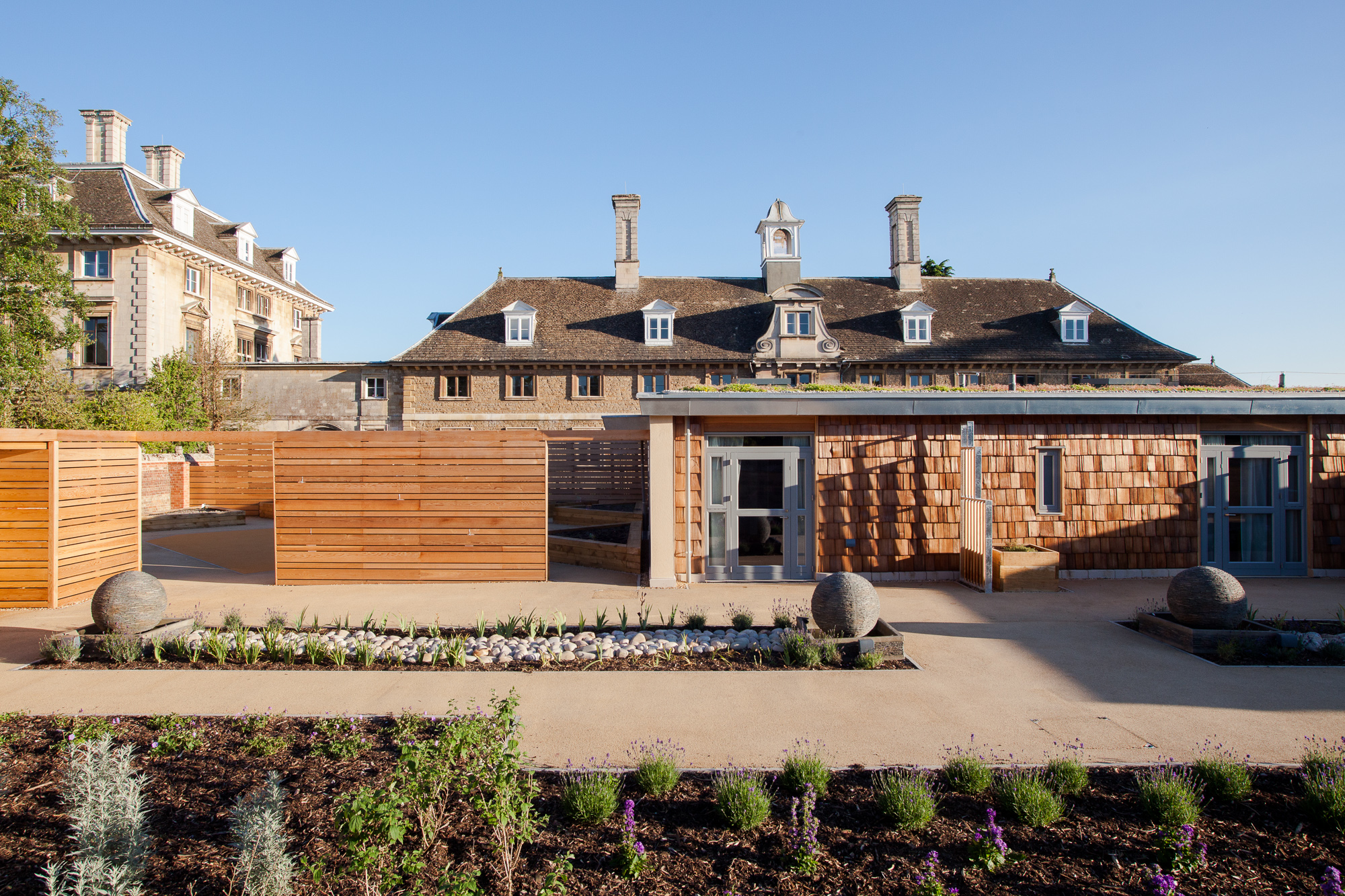
Jane Darbyshire and David Kendall were highly commended in the Best End-of-Life Care Development category for Thorpe Hall Hospice
Best End-of-life Care Development
Highly commended:
Jane Darbyshire and David Kendall for the new inpatient unit at Thorpe Hall Hospice, Peterborough
Originally built in 1653, the Grade I-listed Thorpe Hall remains one of the best-preserved Cromwellian mansions in England.
Rescued from dereliction by Lady Sue Ryder in 1986, it has been a hospice at the heart of the Peterborough community ever since.
Although committed to the stewardship of Thorpe Hall, the charity wanted to provide modern inpatient accommodation.
Jane Darbyshire and David Kendall Architects collaborated with stakeholders to design an extension within the walled garden.
The new unit provides 20 single en-suite bedrooms with support accommodation and is conceived as a pavilion set within formal gardens. It is connected by a glazed link to Thorpe Hall’s West Wing, which has already been refurbished to provide support and day services accommodation.
Jane Petit, hospice director, said, “From the moment anyone comes into the new building the changes the environment has helped to deliver are palpable. The provision of single rooms with en-suite bathrooms, and direct access to a variety of garden areas was always a priority. However, I don't think any of us had imagined how immediate the change would be. We now have an environment that supports the incredible care we provide and that is designed to work with us for the benefit of the patients and their families.”
The judges added: “We like the way it focuses on the gardens as well as the building itself. It has fitted in really well behind a very old building.”
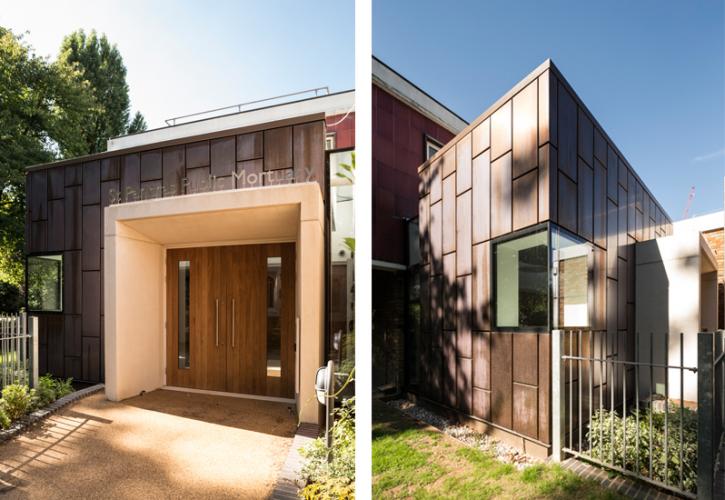
St Pancras Public Mortuary (Paul Murphy Architects)
Paul Murphy Architects for St Pancras Public Mortuary
Camden Council required a comprehensive refurbishment of its existing public mortuary located on the ground floor of the Denis Geffin Annexe in Camden.
The site is located within the Kings Cross/St Pancras Conservation Area and the mortuary co-exists and forms a mutually-supporting role with the neighbouring coroner’s court, a listed Grade II-listed building and reportedly the oldest purpose-built coroner’s court in the country.
The existing facility also borders St Pancras Gardens, an urban oasis that contains St Pancras Old Church, Sir John Soane’s Mausoleum, and a series of Victorian memorials.
The context was therefore very sensitive in architectural terms.
The design involved the comprehensive reconfiguration and replanning of the internal spaces to address the shortcomings of the existing facility. This involved the creation of a new post mortem suite, with a separate suite for performing forensic post mortems independently of the main suite. Increased body storage facilities were also provided, together with a new secure and covered delivery area, and an observation gallery for visitors who may need to witness a procedure. In addition, staff areas were relocated and arranged around a new entrance, with offices and staff change and welfare facilities.
And the project involved the complete replacement of the mechanical and electrical services to create new low-carbon, energy-efficient systems.
The judges said: “This is a wonderful space for relatives to visit. It used to be a bit grim and now it is a civilised experience. It is nicely arranged with good views to the outside.”
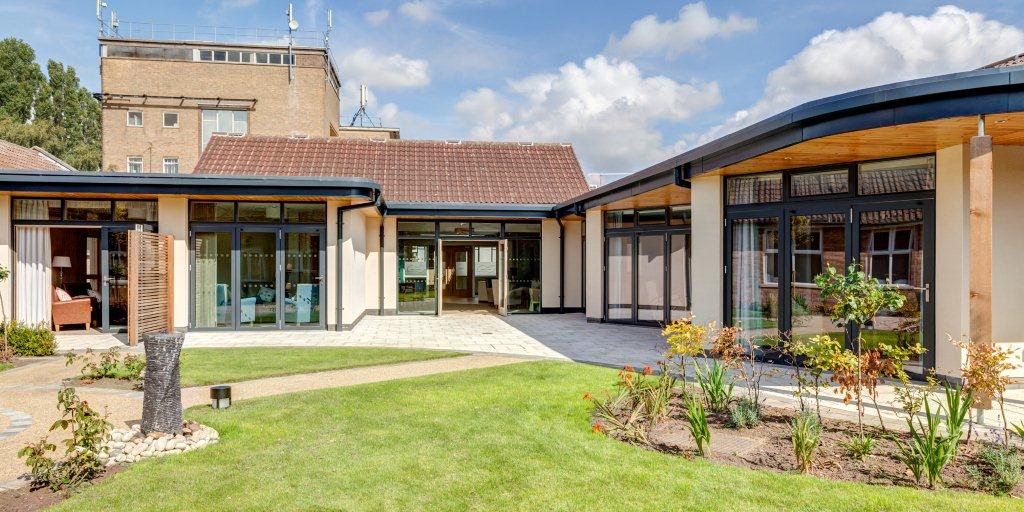
Grantham and District Hospital won the Award for Best End-of-Life Care Development for its Hospice in a Hospital project
WINNER:
Grantham and District Hospital for its Hospice in a Hospital (South West Lincolnshire Clinical Commissioning Group, St Barnabas Lincolnshire Hospice, United Lincolnshire Hospitals NHS Trust, Franklin Ellis Architects, St Barnabas Lincolnshire Hospice)
Described by the judges as ‘a clever idea that demonstrates great partnership working’, The Hospice in the Hospital unit opened in September 2014 and provides six nurse-led community palliative care beds supported by GPs within an acute hospital site - a first of its kind for the UK.
The £1.2m unit within Grantham and District Hospital, unit was developed through collaboration between South West Lincolnshire Clinical Commissioning Group, St Barnabas Lincolnshire Hospice, and United Lincolnshire Hospitals NHS Trust.
At an early stage, patients, families and members of the public were consulted about the project and, together with lessons learned from the King’s Fund’s Enhancing the Healing Environment Programme, helped shape the final plans and the interior design.
The theme of ‘Trees’ was agreed, which influenced the choice of colours, fabrics, furniture, and fittings for the unit and, remarkably, a traditional clinical space was transformed to provide a calm, safe and welcoming environment for patients, families and staff.
The individual en-suite bedrooms are spacious and include a sitting area for patients and relatives. The large wetroom facilities enable staff to comfortably provide assistance to patients where necessary, and discussion with patients and carers about their wishes led to the inclusion of items such as free wi-fi, electric window controls, and folding patio doors that enable patients to go outside, in beds if desired, to enjoy the landscaped garden.
Facilities for relatives include an en-suite bedroom and several lounge areas where they can retire when they need some quiet, personal time.
A local artist whose partner had been cared for by St Barnabas, produced unique artwork for every bedroom and stunning acrylic screens for the reception area. Students from the local college also produced work.
Recently, a separate entrance combining direct access and dedicated free car parking has been developed.
Since opening, 120 patients have been admitted to the unit.
Ian Hayden, facilities manager at Grantham and District Hospital, said: “The Hospice in a Hospital is a beautiful facility, but behind this is a team of committed organisations and determined individuals, who have demonstrated the true power of collective leadership.
“By remaining focused on the specific needs of patients and their families at the end of life, the team has demonstrated that patient-centred leadership, although challenging, creates the foundation for cultural change and transformation of care.
“In short, the opening of the Hospice in the Hospital was not the end of a project, but the start of a shared journey to ensure that, regardless of location or diagnosis, patients are afforded the care they require to die peacefully and live well until they die.”
The judges added: “The old medical assessment unit has been transformed into a beautiful and tranquil space, both internally and externally. The bedrooms are of a good size with tranquil views, which is just what you would want, and patient privacy has been considered. The garden is lovely and there are many small seating spaces.”
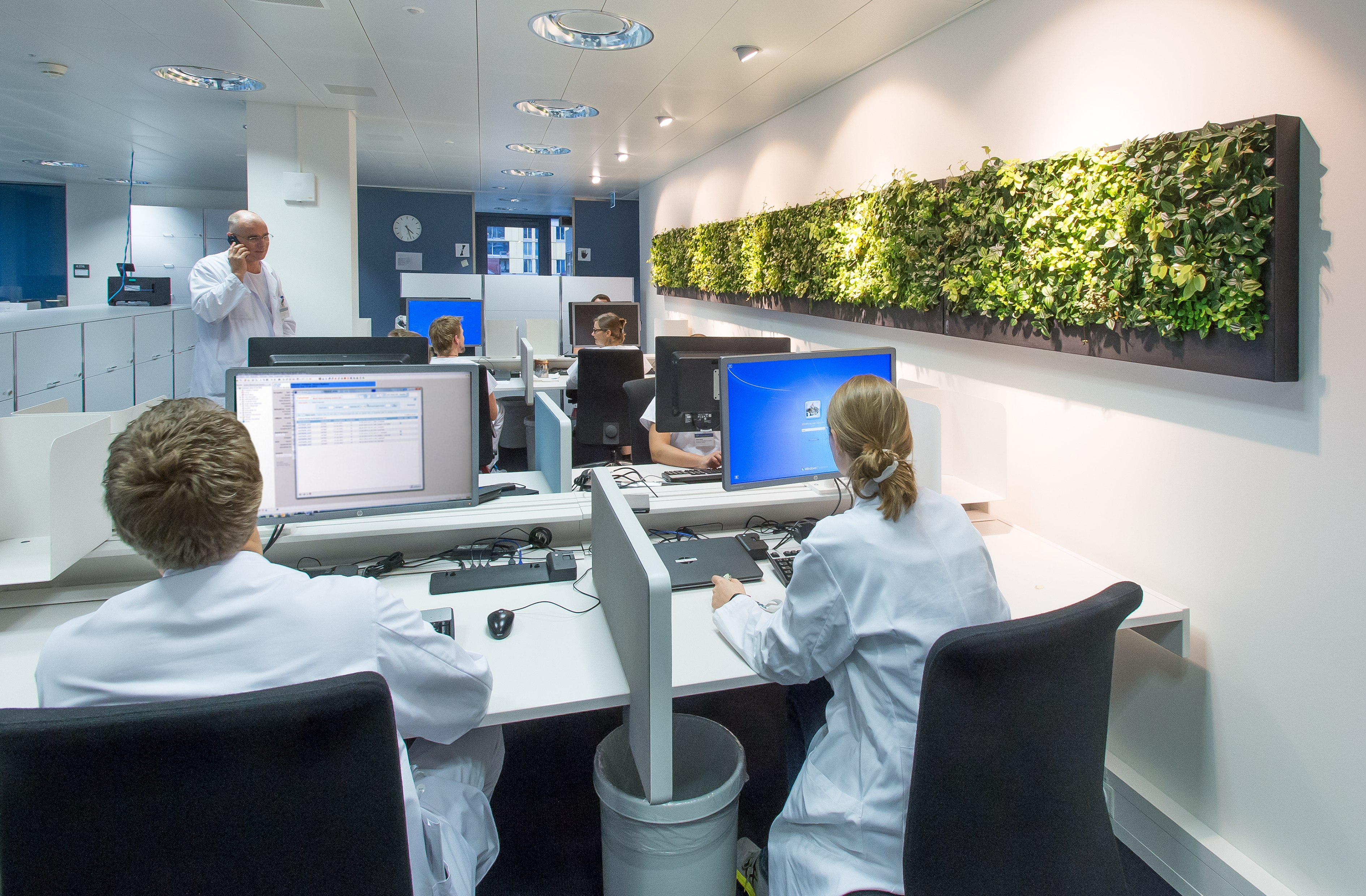
Winterthur Cantonal Hospital (offconsult)
Best International Development
Highly commended:
offconsult for the co-design of the hybrid workplace at Winterthur Cantonal Hospital, Switzerland
Winterthur Cantonal Hospital (KSW) in Switzerland recognised the need to transform the work environment and has introduced a pilot project to examine the potential of mobile working among doctors.
The hospital also needed to accommodate a rapid growth in staff and optimise the use of space through workplace management.
Two questions arose: How to create an open workplace environment for doctors that is quiet and at the same time promotes collaboration? And, what design strategy would help to create a cohesive workplace that would boost the quality and efficiency of doctors’ work?
Interviews and workshops yielded enough insights to develop a workplace design solution that was enjoyable to spend time in, and practical to use.
In this refurbishment project, noisy activities are zoned separately from the quieter workplace areas, and there is a separate zone where doctors can work in small teams or as individuals, as well as spaces where they can meet with others. Enclosed focus rooms and a small huddle room for two people are located in close proximity to open-plan areas to provide alternative places to dictate patient records, take phone calls, and work without distraction.
The design includes acoustic measures to lower background noise, such as the use of carpeting, privacy panels at workbenches, a green wall, acoustic walls, and semi-transparent curtains.
The judges said: “This entry shows how speaking to clinicians can lead to much better ways of working, enabled through good design.”

HOK Architects won the Award for Best International Development for the Sidney and Lois Eskenazi Hospital
WINNER:
HOK Architects for Sidney and Lois Eskenazi Hospital
Eskenazi Health’s new public hospital located on the Indiana University School of Medicine campus advances innovative ideas in healthcare design and patient care.
Replacing the nearby Wishard Medical Center, the new 37-acre complex presented an opportunity for a complete transformation that is rare in urban academic medical centre settings.
HOK Architects worked closely with the senior leadership committee, user group teams, and the programme manager to translate their expectations into the design of the 1.4million sq ft replacement facility.
The concept for the new Sidney & Lois Eskenazi Hospital began with an expanded notion of the ‘public realm’. First and foremost was the desire to create a composition of buildings that serves the public’s interests and health concerns, and also establishes a civic identity of space and form integral to the broader context of healthcare, education and culture.
Avoiding a massive single structure, the hospital elements were assembled into distinctive programmes and reassembled into a series of linked buildings and spaces. This is complemented by the natural open spaces formed by thoughtful composition and placement of buildings. This integration of building and exterior space provides an efficient solution for patient care and accommodates the significant need for areas for respite, contemplation and forum.
The exterior design reflects the ideal internal organisation. Structured around a central green space, the medical centre includes a 319-bed hospital linked by a two-level concourse to a 200-room ambulatory care clinic, a faculty office building, a 2,600-car parking garage, two utility buildings, and public plazas.
The public realm incorporates extensive use of glass to create a great degree of transparency.
Gardens and open spaces are key design features, for example an intimate Sky Farm on top of the clinic building promotes education, healthy eating habits, and a sense of community. A centrally-located, large open-air plaza features a collection of interactive water features, green spaces, a free-standing restaurant and a variety of seating options.
Every aspect of the design focuses on the health and wellness of patients. Reorganising care delivery for all key departments has streamlined patient movement and eliminated wasted space. As a result, patient transitions are down from 3.5 to less than 1.5 times. To maximise efficiency for physicians, the design aligns horizontal platforms of inpatient care with corresponding ambulatory clinics. The efficient plan enables the new hospital to treat 20% more patients in one-third less space.
The naturally-illuminated interior spaces are filled with more than 100 original works of colourful art, including an interactive display in the elevator lobby.
For sustainability, use of low-flow fixtures has reduced potable water usage by 40% and exterior landscape areas harvest enough rainwater to account for 100% of the campus’ irrigation needs. In addition, the building uses 100% outside air for the ambulatory care building and hospital, reducing the risk of infection or other contaminants that might recirculate within the space.
In post-occupancy evaluations, the design decisions have shown a variety of positive impacts. Using same-handed rooms throughout has cut down on staff training needs and increased overall scheduling flexibility; while including a continuous rail from the bed to bathroom, along with hourly rounding, has decreased patient falls by 28%. Locating sinks right inside the doors of patient rooms has improved handwashing compliance scores from 43% to over 75%; and switching to private patient rooms and using a new alarm system has addressed noise levels and increased patient satisfaction levels to more than 80%.
The judges described it as ‘a really lovely building’.
Best Dementia Care Development
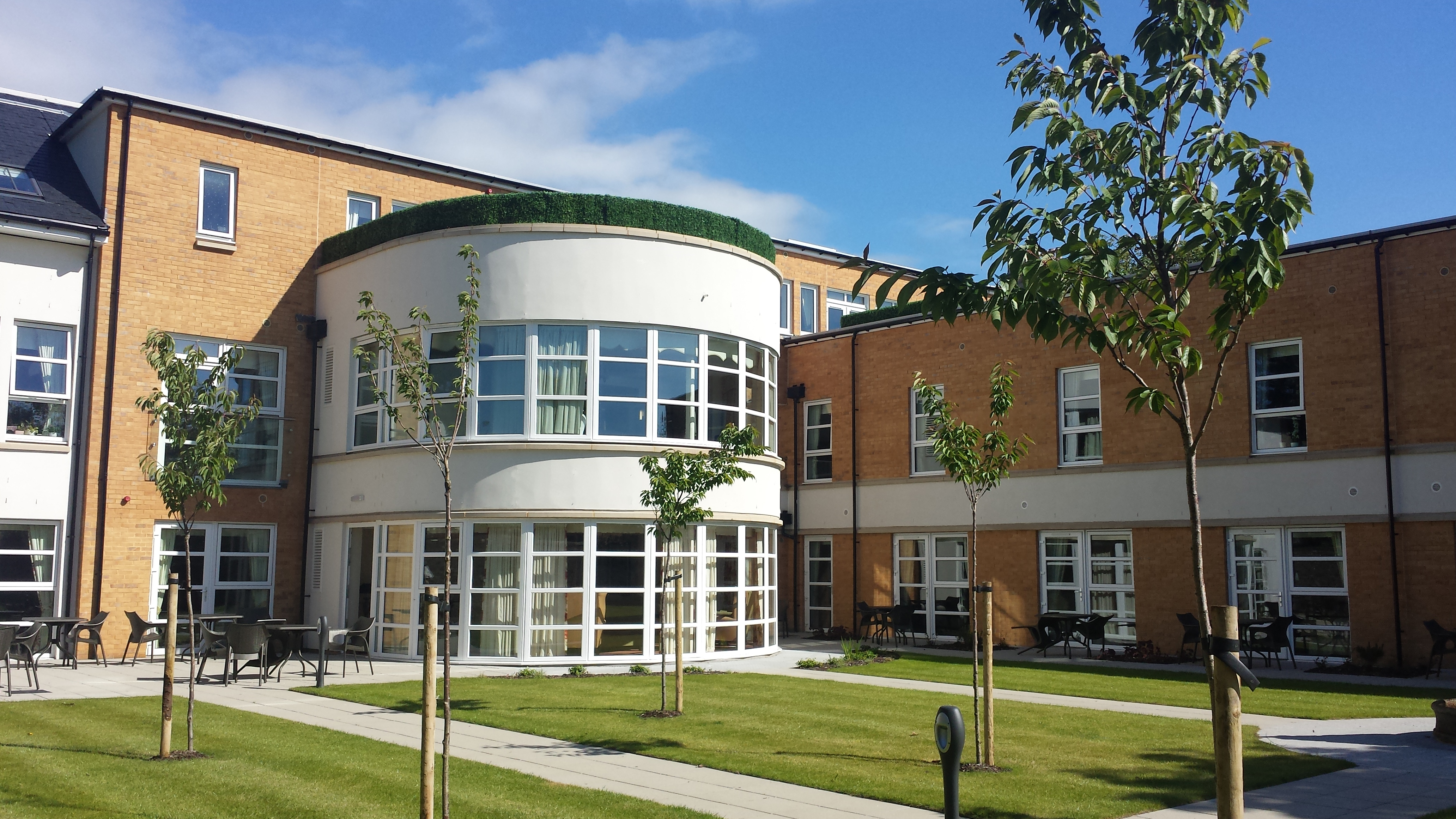
Templeton House Care Home (Robert Potter and Partners)
Highly commended:
Robert Potter and Partners LLP for Templeton House Care Home, Ayr
Templeton House Care Home is located within the conservation area in Ayr.
The site contained a fire-damaged Italianate villa and the redevelopment responded to the sensitive setting.
The new-build solution preserves and incorporates the front façade of the villa, balancing this with a new modern pavilion and core accommodation.
The central link building provides the heart of the care home, with atrium circulation, coffee shop, cinema room, private dining room, hair salon, spa and activity spaces. Beautiful interiors include high-quality finishes, a bar, and a grand piano.
Each of the 72 bedrooms has views to the gardens, with large windows, balconies, patio doors and ‘secret’ roof gardens used to take advantage of the picturesque local scenery.
The landscaped grounds are designed to be dementia-friendly and have the feeling of a historic walled garden, enclosed by sandstone walls and mature trees and providing safe walking routes, visual interest throughout the year, a putting green, and a variety of sitting and activity areas.
Internal finishes were selected to provide good visual contrast while using familiar materials and the sustainability strategy focused on providing a comfortable internal environment, with individual heating control for each room and quiet ventilation to maintain good internal air quality.
Combined heat and power units provide on-site electricity generation, with heating provided as a by-product. Low-energy lighting and automatic controls are also used.
The judges said: “This is a lovely building with exceptional grounds.”
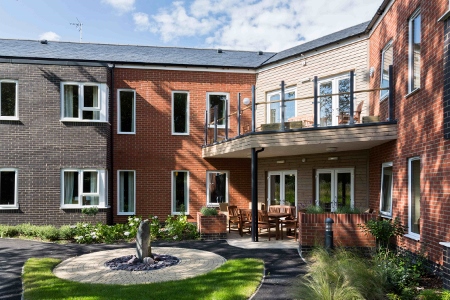
Fremantle Court won the award for Best Dementia Care Development
WINNER:
Hunter and Partners for Fremantle Court (Hunters Architects, The Fremantle Trust, Castleoak)
Described by the judges as ‘non institutional, with nice gardens and a light, bright, domestic feel’, Fremantle Court is a flagship 90-bed care home designed with one purpose in mind - to provide a happy, comfortable, desirable and safe place to live and work.
Part of a new generation of dementia-friendly care homes, the facility in Stoke Mandeville has been awarded the ‘Gold Standard’ from the University of Stirling’s Dementia Services Development Centre.
The scheme has a country hotel feel and is arranged around households of 15 split into groups of seven or eight residents.
Residents maintain their independence with freedom of choice to do or go where they want.
Destinations include homely lounges, winter gardens, seating areas, and a central ‘home’. Open-plan areas reduce staff anxiety about not being able to see residents; and splayed corridors allow space for intimate break-out areas coupled with plants and other life-enhancing objects.
Fremantle Court also provides excellent care, support and facilities for local residents, which were previously undersupplied in the area and provides employment, apprenticeship and volunteering opportunities.
Each well-appointed wing has its own sitting room, dining room and assisted bathroom; while central courtyards provide orientation, light, natural ventilation and enclosed gardens, with sensory plants.
The whole home has been designed to be dementia friendly – even the non-dementia wings. All toilet and bathroom doors are the same colour and the doors slide to reduce risk of falls. The walls have been painted in a non-reflective paint and in a colour palette that is dementia friendly.
The design principles used in the scheme are already redefining care concepts on other best practice schemes; and the unique layout, with splayed ‘living wings’ which fan out from the centre of the building, has become a blueprint for future design.
Jan Lovett, service manager, said: “The layout means there are lots of different spaces for residents and their families, some where people can engage with others and others where they can spend private or quiet time.
“Residents can independently access all core areas and staff can observe people without intruding. The splayed corridors work really well and they have reduced isolation for those residents who remain in their rooms.”
Resident, Edna Tapping, added: “The outside area means I can enjoy all of the lovely countryside around the home while being safe and looked after.”
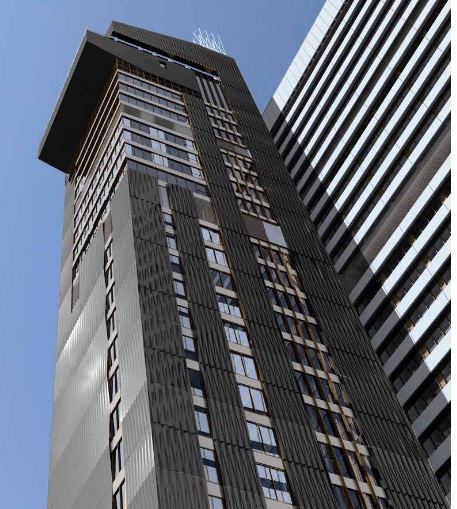
Guys Tower has been reclad
Best Sustainable Development
Highly commended:
Essentia, Guy’s and St Thomas’ NHS Foundation Trust for Guy’s Tower recladding project
Guy’s and St Thomas’ NHS Foundation Trust had a once-in-a-lifetime opportunity to improve the appearance and thermal efficiency of Guy’s Hospital Tower, the tallest hospital building in the world, while also fixing 40 years of environmental damage.
The building’s façade was deteriorating, inhabitants were often uncomfortable due to solar gain or draughty windows, and a complete overhaul was needed.
The concrete was also in a poor state of repair and the windows were at the end of their life, resulting in negative impact on the building’s energy efficiency.
A key aim of the revamp was to improve energy efficiency, and the building’s resilience to a changing climate with hotter summers.
The decision to reclad the tower was driven by a desire to ensure the longevity of an iconic building by addressing structure, aesthetics, and environmental impact.
The project included fitting 8,000sq m of bespoke, hand-folded aluminium cladding to cover the existing concrete, adding additional insulation of 180mm; 12,000sq m of high-performance, double-glazed windows with solar-selective glass; cleaning and resealing damaged concrete, revealing the original ‘white’ cement and improving the aesthetics; and creating 48sq m of additional floorspace per floor through the removal of the old façade.
The recladding was achieved on time and under budget, with no missed clinical appointments. It has increased healthcare efficiency and is saving the trust £111,000 a year through a reduction in maintenance and energy costs. During its 30-year lifecycle, over 8,000 tonnes of CO2 will also be saved through improved thermal performance.
The judges said: “They were originally going to knock down the existing tower block and instead decided to reclad it. The figures are extraordinary and show what savings can be made, both financially and in terms of the environmental impact of a development.”
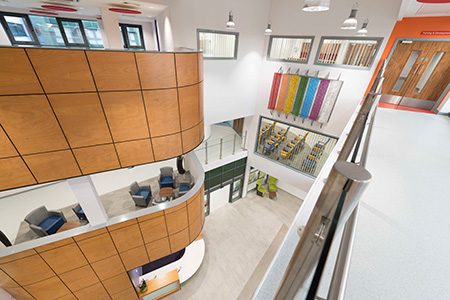
Interserve won the Award for Best Sustainable Development for The Walton Centre, Sid Watkins Building
WINNER:
Interserve for The Walton Centre, Sid Watkins Building (Interserve, Gilling Dod Architects)
Liverpool’s Walton Centre is the only specialist neurosciences NHS trust in the UK, admitting patients from across the country.
Capacity demands prompted the development of the exemplary new Sid Watkins Building, delivered via the NHS ProCure21+ framework.
The three-storey building provides specialised inpatient rehabilitation, outpatient care, education and training facilities, as well as offices and overnight accommodation for relatives.
Close liaison with patients, staff and visitors influenced the team to break from traditional NHS design, delivering a first-class patient and visitor experience closer to that of a five-star hotel.
Interserve took an innovative approach to the construction of the building in order to reduce its carbon impact, working with the trust to develop a low-carbon strategy that, while requiring additional capital investment, will create significant energy cost savings and reduce carbon emissions over the life of the building.
Interserve’s ‘Fabric First’ approach draws upon its Passivhaus experience, adopting skills, competences and details to promote passive heating and ventilation and achieve better air tightness, which together with the choice of external fabric makes the building more energy efficient, reducing energy usage and therefore costs.
Interserve developed a ‘Fabric First Calculator’ which provided an accurate analysis of increased capital expenditure and saving on running costs in respect of seven different fabric alternatives, ranging from meeting Part L of the Building Regulations, to full Passivhaus standards. This allowed the client to make a more-informed decision.
Other options included prefabricated, hybrid and traditional approaches to construction.
The team demonstrated that a hybrid solution would offer best value for money and improve certainty of delivery. The client opted to go for a fabric solution that improved the building fabric U values by 20%, for an additional capital cost of £200,000, reduced to £100,000 by the £100,000 saving in the capital cost of M&E services. This would be paid back in less than five years.
The Fabric First Calculator included an annual 5% increase in energy costs and, for the option chosen, predicted total energy savings of over £1m over the life of the building. In reality the savings are likely to be between £3m-5m since actual energy inflation costs are higher than the 5% used in the calculator.
This option will also enable:
- 41% reduction in fabric loss heat, generating a £95,745 saving in engineering capital costs
- 29% reduction in carbon emissions, futureproofing the building
- 96,400 kg of CO2 saved per year
- Total annual energy usage 21 GJ/100m³, some 14GJ/100m³ under NHS benchmark
- 15% reduction in overall energy usage
Methods and materials used during construction included optimising thermal efficiency, reducing thermal bridging, ensuring superior air tightness, and the extensive use of off-site manufacturing processes. For example, lifts and stairwells are pre-cast, the external fabric was prefabricated off-site in structurally-framed panels and complemented by modularised service risers prefabricated off-site by Interserve Engineering Services. Low-energy lighting components were also specified throughout. The savings in capital costs were reinvested into the project to provide an additional third floor for free, making the building futureproof and flexible to meet future healthcare needs.
The judges said of the entry: “Really good stuff has been done throughout the entire delivery of this building.”









